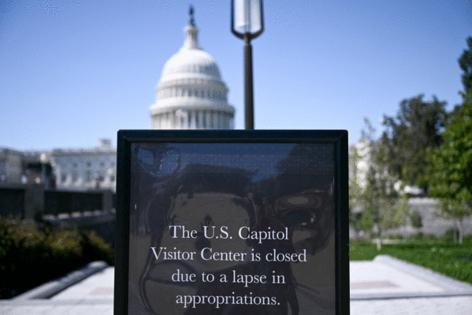Shutdown pause on federal economic data leaves auto sellers, analysts in the dark
Published in Business News
WASHINGTON — The ongoing federal government shutdown is leaving auto sellers without key economic data and obscuring the impact of President Donald Trump's signature tariff policies.
That's because the budget lapse, among other consequences, has triggered a pause in the publication of indicators that typically inform industry decisions. Policymakers and businesses have now gone more than a month without new federal figures on tariff costs, manufacturing productivity, inflation, employment and more.
"The countries that are most successful are the ones where you know what your price levels are, your number of jobs, your costs, your tariffs and your taxes," said Lansing-based economist Patrick Anderson, CEO of Anderson Economic Group. "That's one of the reasons that countries which haven't developed highly credible, trained statistical reports that aren't governed by elected officials have so much economic difficulty."
Anderson and other industry analysts noted that the temporary dearth of data is unlikely to affect the biggest business moves from automakers, which tend to make capital investments and production plans on years-long time horizons. But short-term implications for vehicle sales, experts said, could start to pile up.
"While vehicle development in the industry operates at a glacial pace requiring years to bring a vehicle to market, constant monitoring of the economic data is necessary to make the fine adjustments to marketing, production, and retailing of those vehicles," said Sam Fiorani, vice president of global vehicle forecasting for AutoForecast Solutions.
The analyst added: "Not knowing where the market is heading could mean too many or too few vehicles in inventory and, likely, the wrong mix of trim levels. Allowing a manufacturer to more accurately predict changes in the market means shipping the right vehicles to the proper regions and preparing incentives when conditions sour."
Ford Motor Co. and Stellantis NV both did not comment on how the data drought is affecting their business. General Motors Co. said there has not been any impact.
Automakers, dealers and analysts rely on troves of internal and private-sector data that are not available to the masses, but public data still plays a helpful role, according to Fiorani: "All forecasters, especially those in the automotive industry, need data and the federal government provides a number of great measures of the economy."
The National Automobile Dealers Association offered a similar assessment: "While government data can be a useful tool for automobile dealers, generally, they don't rely on it exclusively. Many dealers rely on industry sources for data that informs their business decisions," spokesperson Amy Wright said in a statement.
But as the government shutdown (34 days old at the time of publication) stretches deeper into its second month, existing government statistics are becoming more outdated. Decision-makers are having to make do without some of their usual sources.
"The longer the data is missing, the less accurate the outlook becomes," Fiorani said.
Private substitutes for public data
The Federal Reserve, notably, voted last week to cut a key interest rate by a quarter point despite not having access to the employment and inflation information often central to its policy directives. Fed Chair Jerome Powell did not offer a clear signal on the bank's upcoming December rate decision amid the partial data blackout.
"If there is a very high level of uncertainty, then that could be an argument in favor of caution about moving," Powell told reporters after the latest rate cut, which will likely make new auto loans slightly more affordable. "But we'll have to see how it unfolds."
There is some private-sector data to help the Fed and other businesses navigate without the full complement of data from statistical agencies like the Bureau of Labor Statistics and the Census Bureau, but there is a noticeable dropoff in reliability, according to the Peterson Institute for International Economics.
Jed Kolko, a senior researcher for the nonpartisan think thank, explained the data differences in an Oct. 30 blog post.
"The shutdown reinforces what statisticians and economists have long argued: Private sector data is valuable but cannot replace official statistics," Kolko wrote. "Private sources offer speed, specificity, and innovation that complement government data. They can track emerging trends, provide granular detail for particular sectors or geographies, and offer near real-time updates. But they cannot match the breadth, representativeness, consistency, transparency, or public commitment of official statistics."
He cited federal jobs data as an example of imperfect private substitutes: "When the September jobs report was delayed, multiple private sector alternatives stepped in. ADP continued publishing payroll figures, newer entrants like Revelio Labs joined the field, and firms including the Carlyle Group weighed in with payroll growth estimates.
"Historical analysis suggests these sources are rough and imprecise predictors of the official nonfarm payroll number, with methodological differences in coverage, revision timing, and data collection making direct comparisons tricky."
For the auto industry and other areas of Michigan's manufacturing-heavy economy, analysts noted other missing measures that have them in the dark.
"The data pause is certainly affecting things," said Jason Miller, a professor of supply chain management at Michigan State University. "For example, we right now lack a good sense of: How is production in different sectors of manufacturing changing? How is employment evolving in different sectors of the economy?"
"One sector I watch closely is wholesale trade, as downturns in employment have closely corresponded to recessions," he continued. "We had been seeing a sharp fall in payrolls as of August. Has this continued?"
Warren Browne, an automotive consultant and former GM executive, raised concerns about tariffs stemming from missing international trade data and about potential contract disputes between automakers and their suppliers stemming from the lack of an updated Producer Price Index.
"Finance arms of OEMs still can use the Fed’s interest rate data. However, determining if suppliers' requests for price increases are real could be problematic," he said. "Likewise, determining cost-of-living adjustments in contracts will cause friction."
Fuzzy tariff picture
New data on tariffs and U.S. international trade for September was supposed to come out on Nov. 4, but the release was suspended due to the shutdown. The Census Bureau also missed a similar release in October. The latest available federal data on the topics goes through July.
Because of that, there is an increasingly stale public picture of how tariffs are hitting Michigan's signature industry. Browne, commenting on missing tariff data, said that not being "able to understand the competitive pressure on import competitors could hurt when trying to set 2026 pricing."
One important trend in the July data was mounting automotive tariffs on goods from Canada and Mexico. Canada's assessed duty rate on automotive goods rose from about 3% in June to 11% in July, while Mexico's rate rose from 8% to 11%. In total cost terms, duties charged on Mexican auto goods that month ($1.5 billion) far exceeded all other countries. Japan ranked second at roughly $1 billion.
The upward trend for import taxes on Canadian and Mexican automotive products — which are key to an integrated North American supply chain — has worried automakers and industry leaders who have stressed the importance of regional production as an antidote to the long-running trend of manufacturing moving overseas to Asia.
The United States charges tariffs of 25% on the non-U.S. content of vehicles imported from its neighboring nations, even if the vehicles comply with the U.S.-Mexico-Canada free trade agreement. Procedures for assessing those charges were not published until May 20.
With that system now in fuller effect, July was a "turning point" for North American automakers, according to an analysis by the Anderson Economic Group. Exemptions for goods coming from Mexico and Canada became markedly less common than in previous months.
But without the publication of federal tariff data for months, the continued growth or abatement of that trend is unclear.
In January through July, the United States charged importers about $6.4 billion in tariffs for vehicles and auto parts from Mexico and Canada, according to a recent AEG report. The group projected an additional $4.2 billion through October, assuming levies consistent with the July levels. But that assumption could be far off if Trump administration became even more aggressive on tariffs during those months.
Anderson lamented the lack of available federal data: "Honest statistics aren't perfect. You revise them, but they have been reliable. If you go to other countries, such as China, that's not the case. And we are now giving up one of our advantages over other countries by shutting down our statistical agencies."
©2025 www.detroitnews.com. Visit at detroitnews.com. Distributed by Tribune Content Agency, LLC.












Comments